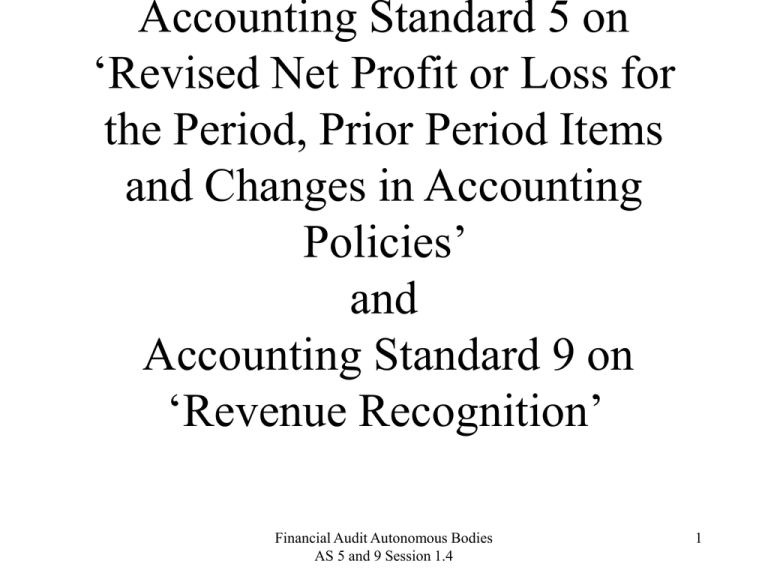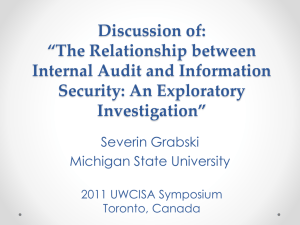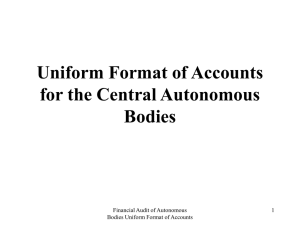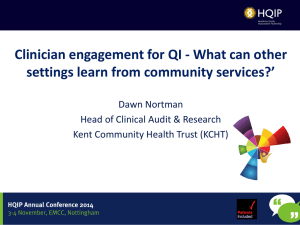Accounting Standards, AS 5 and AS 9 on ` Revised Net Profit or Loss
advertisement

Accounting Standard 5 on ‘Revised Net Profit or Loss for the Period, Prior Period Items and Changes in Accounting Policies’ and Accounting Standard 9 on ‘Revenue Recognition’ Financial Audit Autonomous Bodies AS 5 and 9 Session 1.4 1 • All entities are faced with the alternatives in adjustment of prior period items and take into account any changes in the accounting policies at the time of preparation of their financial statements and of recognition of revenue as and when financial statements are prepared. Adjustment of prior period items and recognition of revenue are capable of different treatment while preparing financial statements. AS 5 and AS 9 try to bring uniformity in these areas. Financial Audit Autonomous Bodies AS 5 and 9 Session 1.4 2 Points to be covered in this session • During this session we will learn about treatment of: • Prior Period Items and Changes in Accounting Policies; and • Recognition of Revenue; Financial Audit Autonomous Bodies AS 5 and 9 Session 1.4 3 Learning objective • At the end of this session, the learner will be able to explain various provisions contained in the Accounting Standard –5 and Accounting Standard-9 to the extent that he, as an Auditor, will be able to apply these Standards during the audit of Financial Statements. Financial Audit Autonomous Bodies AS 5 and 9 Session 1.4 4 Accounting Standards (AS 5) Revised Net Profit or Loss for the Period, Prior Period Items and Changes in Accounting Policies Financial Audit Autonomous Bodies AS 5 and 9 Session 1.4 5 Accounting Standards 5objective • The objective of this Statement is to prescribe the classification and disclosure of certain items in the statement of profit and loss so that all enterprises prepare and present such a statement on a uniform basis. Financial Audit Autonomous Bodies AS 5 and 9 Session 1.4 6 Definitions • Ordinary activities are any activities which are undertaken by an enterprise as part of its business and such related activities in which the enterprise engages in furtherance of, incidental to, or arising from, these activities. Financial Audit Autonomous Bodies AS 5 and 9 Session 1.4 7 Definitions • Extraordinary items are income or expenses that arise from events or transactions that are clearly distinct from the ordinary activities of the enterprise and, therefore, are not expected to recur frequently or regularly. Financial Audit Autonomous Bodies AS 5 and 9 Session 1.4 8 Definitions • Prior period items are income or expenses, which arise, in the current period as a result of errors or omissions in the preparation of the financial statements of one or more prior periods. Financial Audit Autonomous Bodies AS 5 and 9 Session 1.4 9 Definitions • Accounting policies are the specific accounting principles and the methods of applying those principles adopted by an enterprise in the preparation and presentation of financial statements. Financial Audit Autonomous Bodies AS 5 and 9 Session 1.4 10 Definitions • Ordinary activities are any activities which are undertaken by an enterprise as part of its business and such related activities in which the enterprise engages in furtherance of, incidental to, or arising from, these activities. Financial Audit Autonomous Bodies AS 5 and 9 Session 1.4 11 Net Profit or Loss for the Period • All items of income and expense which are recognized in a period should be included in the determination of net profit or loss for the period unless an Accounting Standard requires or permits otherwise Financial Audit Autonomous Bodies AS 5 and 9 Session 1.4 12 Net Profit or Loss for the Period • The net profit or loss for the period comprises the following components, each of which should be disclosed on the face of the statement of profit and loss: a.profit or loss from ordinary activities; and b.extraordinary items Financial Audit Autonomous Bodies AS 5 and 9 Session 1.4 13 Extraordinary Items • 8. Extraordinary items should be disclosed in the statement of profit and loss as a part of net profit or loss for the period. The nature and the amount of each extraordinary item should be separately disclosed in the statement of profit and loss in a manner that its impact on current profit or loss can be perceived. Financial Audit Autonomous Bodies AS 5 and 9 Session 1.4 14 Profit or Loss from Ordinary Activities • When items of income and expense within profit or loss from ordinary activities are of such size, nature or incidence that their disclosure is relevant to explain the performance of the enterprise for the period, the nature and amount of such items should be disclosed separately. Financial Audit Autonomous Bodies AS 5 and 9 Session 1.4 15 Prior Period Items • The nature and amount of prior period items should be separately disclosed in the statement of profit and loss in a manner that their impact on the current profit or loss can be perceived. Financial Audit Autonomous Bodies AS 5 and 9 Session 1.4 16 Changes in Accounting Estimates • The effect of a change in an accounting estimate should be included in the determination of net profit or loss in: a.the period of the change, if the change affects the period only; or b.the period of the change and future periods, if the change affects both. Financial Audit Autonomous Bodies AS 5 and 9 Session 1.4 17 Changes in Accounting Estimates • The effect of a change in an accounting estimate should be classified using the same classification in the statement of profit and loss as was used previously for the estimate. Financial Audit Autonomous Bodies AS 5 and 9 Session 1.4 18 Changes in Accounting Estimates • The nature and amount of a change in an accounting estimate which has a material effect in the current period, or which is expected to have a material effect in subsequent periods, should be disclosed. If it is impracticable to quantify the amount, this fact should be disclosed. Financial Audit Autonomous Bodies AS 5 and 9 Session 1.4 19 Changes in Accounting Policies • A change in an accounting policy should be made only if the adoption of a different accounting policy is required by statute or for compliance with an accounting standard or if it is considered that the change would result in a more appropriate presentation of the financial statements of the enterprise. Financial Audit Autonomous Bodies AS 5 and 9 Session 1.4 20 Changes in Accounting Policies • Any change in an accounting policy, which has a material effect, should be disclosed. The impact of, and the adjustments resulting from, such change, if material, should be shown in the financial statements of the period in which such change is made, to reflect the effect of such change. Where the effect of such change is not ascertainable, wholly or in part, the fact should be indicated. If a change is made in the accounting policies which has no material effect on the financial statements for the current period but which is reasonably expected to have a material effect in later periods, the fact of such change should be appropriately disclosed in the period in which the change is adopted. Financial Audit Autonomous Bodies AS 5 and 9 Session 1.4 21 Changes in Accounting Policies • A change in accounting policy consequent upon the adoption of an Accounting Standard should be accounted for in accordance with the specific transitional provisions, if any, contained in that Accounting Standard. However, disclosures required by this Statement should be made unless the transitional provisions of any other Accounting Standard require alternative disclosures in this regard Financial Audit Autonomous Bodies AS 5 and 9 Session 1.4 22 Accounting Standards (AS 9) Revenue Recognition Financial Audit Autonomous Bodies AS 5 and 9 Session 1.4 23 Accounting Standards (AS 9) Revenue Recognition • This Statement deals with the bases for recognition of revenue in the statement of profit and loss of an enterprise. The Statement is concerned with the recognition of revenue arising in the course of the ordinary activities of the enterprise from • the sale of goods, • the rendering of services, and • the use by others of enterprise resources yielding interest, royalties and dividends. Financial Audit Autonomous Bodies AS 5 and 9 Session 1.4 24 Accounting Standards (AS 9) Revenue Recognition • This Statement does not deal with the following aspects of revenue recognition to which special considerations apply: • i. Revenue arising from construction contracts; • ii. Revenue arising from hire-purchase, lease agreements; • iii. Revenue arising from government grants and other similar subsidies; • iv. Revenue of insurance companies Financial Audit contracts. Autonomous Bodies 25 arising from insurance AS 5 and 9 Session 1.4 items not included within the definition of ‘revenue’ • i. Revenue arising from construction contracts; • ii. Revenue arising from hire-purchase, lease agreements; • iii. Revenue arising from government grants and other similar subsidies; • Iv. Revenue of insurance companies arising from insurance contracts. Financial Audit Autonomous Bodies AS 5 and 9 Session 1.4 26 Definitions • 1.1 Revenue is the gross inflow of cash, receivables or other consideration arising in the course of the ordinary activities of an enterprise from the sale of goods, from the rendering of services, and from the use by others of enterprise resources yielding interest, royalties and dividends. Revenue is measured by the charges made to customers or clients for goods supplied and services rendered to them and by the charges and rewards arising from the use of resources by them. Financial Audit Autonomous Bodies AS 5 and 9 Session 1.4 27 Definitions • Completed service contract method is a method of accounting, which recognizes revenue in the statement of profit and loss only when the rendering of services under a contract is completed or substantially completed. Financial Audit Autonomous Bodies AS 5 and 9 Session 1.4 28 Definitions • 1.1 Proportionate completion method is a method of accounting, which recognizes revenue in the statement of profit and loss proportionately with the degree of completion of services under a contract. Financial Audit Autonomous Bodies AS 5 and 9 Session 1.4 29 Accounting Standards (AS 9) Revenue Recognition • This Statement deals with the bases for recognition of revenue in the statement of profit and loss of an enterprise. The Statement is concerned with the recognition of revenue arising in the course of the ordinary activities of the enterprise from • the sale of goods, • the rendering of services, and • the use by others of enterprise resources yielding interest, royalties and dividends. Financial Audit Autonomous Bodies AS 5 and 9 Session 1.4 30 Accounting Standards (AS 9) Revenue Recognition • This Statement deals with the bases for recognition of revenue in the statement of profit and loss of an enterprise. The Statement is concerned with the recognition of revenue arising in the course of the ordinary activities of the enterprise from • the sale of goods, • the rendering of services, and • the use by others of enterprise resources yielding interest, royalties and dividends. Financial Audit Autonomous Bodies AS 5 and 9 Session 1.4 31








